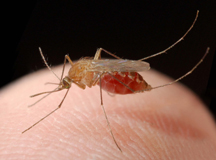
Jed Dillard
Jefferson County Extension Livestock and Natural Resources Agent
Whining hordes of mosquitoes have made life miserable for the warm blooded among us since tropical storm Debby soaked North Florida. You’re likely thinking, “These are not my mama’s skeeters!” The facts bear you out, but this time the facts do bring a sliver of good news.
According to the Florida Medical Entomology Lab in Fort Pierce, eighty species of mosquitoes have been identified in Florida, but “only” thirteen transmit disease to humans or animals. There seems to be a mosquito species for every habitat in Florida. Permanent water species have been out all along reproducing in clogged rain gutters, flower pots, bird baths and every other place a tablespoon of water is available for the ten to twenty days it takes a mosquito to go from egg to adult. All mosquitoes lay their eggs in water. As you might guess, the permanent water species require water throughout their development. Removing standing water sources helps reduce numbers for these species, and their numbers increased after the storm as you might expect.
However, this summer’s rains have brought us a little something extra, floodwater mosquitoes. These species (we have three) have a less well-known life cycle and these are the demons that have really bitten us and our animals since the tropical storm. Floodwater mosquitoes lay their eggs in moist ground. Afterwards the eggs must dry out and then be rehydrated to hatch.
The most notable, but least dangerous as far as disease transmission is concerned, is the large mosquito locals call “gallinippers”, Psorophora ciliata. Ciliata refers to its hairy looking legs. When I came to Jefferson County, folks told me they were so named because they took “a gallon of blood at every nip.” Our recent weather history is the perfect scenario: Mosquitoes laid eggs in wet ground; the ground dried out from yearlong drought; then high rainfall rehydrated the dry creeks, bogs, sloughs and other low places. All these rehydrated eggs hatch at once instead of continuously as the permanent water species do. UF researcher Roxanne Rutledge estimates the number of mosquito eggs in a floodwater habitat between 0.7 and 1.3 million eggs per acre, or about 20 per square foot. No wonder we’ve been besieged!
The good news? Two things-Since floodwater species hatch all at once and require their eggs to dry out, the eggs laid by the recent infestation won’t hatch until the next flood following a drought. With a typical lifespan of two weeks for an adult mosquito, we’re probably out of the woods with this year’s crop of flood mosquitoes. And as waters recede, there will be fewer places for permanent water mosquitoes to lay eggs. Learn more about mosquitoes at the Florida Medical Entomology Laboratory website: http://fmel.ifas.ufl.edu/
It’ll get better! Just try not to scratch.
 0
0
